Canon PowerShot G10
-
-
Written by Gordon Laing
Canon PowerShot G10 resolution comparison
Canon PowerShot G10 results continued…
| Support this site by shopping at Amazon | |||||||||||||||||||||||||||||||||||||||||||
 |
To measure and compare the Canon PowerShot G10’s resolving power we photographed the Enhanced Digital Camera Resolution Chart with it and a number of rival compacts, each using their best quality JPEG and default image tone and sharpening settings. Each camera was tested at every aperture setting and the best result selected for this page. The crops are taken from the original images, saved as High Quality JPEGs in Photoshop CS2 and presented here at 100%. Each number represents 100 lines per picture height (lpph), so a figure of 20 means a resolution of 2000 lpph. |
In terms of resolving power, the Canon PowerShot G10 delivers 2450 lpph of horizontal and vertical resolution. This is around 10% more than its predecessor and the same we measured for the Canon EOS 50D, although the latter was a little better defined. This is a great result for the PowerShot G10, although not without caveats. Diffraction unsurprisingly becomes an issue when you pack this number of pixels into a small area. The G10 only delivered 2450 lpph at its largest aperture and steadily lost resolution as the aperture closed; at its smallest aperture of f8, the resolution had fallen to 2000 lpph. But if you use the G10 at its optimum settings, there’s no denying it can capture a great deal of detail. Canon’s clearly still playing the Megapixel numbers game though, and while the G10 can record a lot of detail at its lowest sensitivity and largest aperture, it begs the question whether there’ll be compromise at higher ISOs – to find out, head onto our Canon G10 High ISO results page. Alternatively, if you’re interested to see whether shooting in RAW can unveil greater detail still (hint – it can), first scroll down to the bottom of this page. |
Canon PowerShot G10 |
Canon PowerShot G9 | |
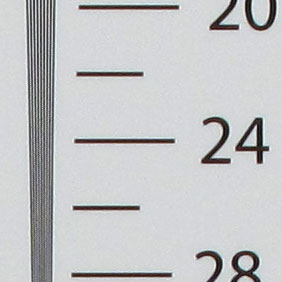 | 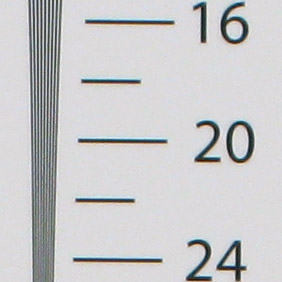 | |
2450 lpph, 6.1-30.5mm at 15mm, f3.5, 80 ISO |
2250 lpph, 7.4-44.4mm at 15mm, f4, 80 ISO | |
Canon EOS 450D / XSi with EF-S 18-55mm IS |
Panasonic Lumix LX3 | |
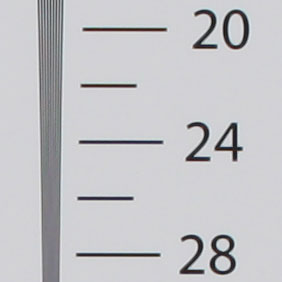 | 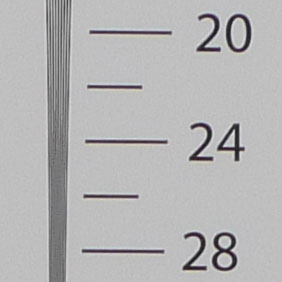 | |
2200 lpph, EF-S 18-55mm IS at 35mm, f8, 100 ISO |
2250 lpph, 5.1-12.8mm at 12.8mm, f2.8, 80 ISO |
Canon PowerShot G10 |
Canon PowerShot G9 | |
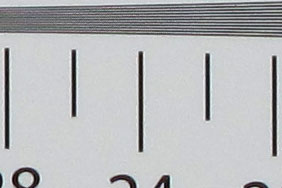 | 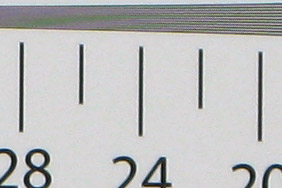 | |
2450 lpph, 6.1-30.5mm at 15mm, f3.5, 80 ISO |
2250 lpph, 7.4-44.4mm at 15mm, f4, 80 ISO | |
Canon EOS 450D / XSi with EF-S 18-55mm IS |
Panasonic Lumix LX3 | |
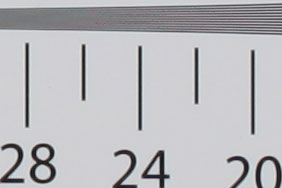 | 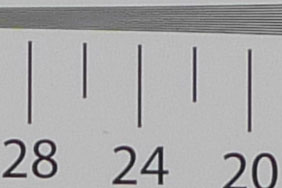 | |
2225 lpph, EF-S 18-55mm IS at 35mm, f8, 100 ISO |
2250 lpph, 5.1-12.8mm at 12.8mm, f2.8, 80 ISO |
Canon PowerShot G10 Studio resolution: JPEG versus RAW
We photographed our test chart in the PowerShot G10’s RAW plus JPEG mode, allowing us to directly compare images created from exactly the same data. Below are 100% crops taken from the original JPEG file alongside the RAW version, processed using the supplied Digital Photo Professional 3.5 and its default settings.
At first glance the converted RAW sample looks much softer than the in-camera JPEG, but a closer look reveals better definition between the converging lines, and a comfortably higher score in this test. Interestingly Canon is applying a fair amount of sharpening and contrast to the G10’s in-camera JPEGs at its lowest sensitivities for a punchy, consumer friendly approach, but if you’re willing to shoot in RAW you’ll ultimately enjoy higher resolution.
Now let’s check out the camera’s performance at different sensitivities in our Canon PowerShot G10 noise results page.
Canon PowerShot G10: JPEG |
Canon PowerShot G10: RAW | |
 | 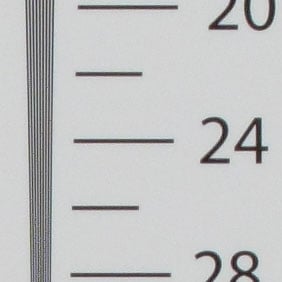 | |
2450 lpph, 6.1-30.5mm at 15mm, f3.5, 80 ISO |
2600 lpph, 6.1-30.5mm at 15mm, f3.5, 80 ISO |
Canon PowerShot G10: JPEG |
Canon PowerShot G10: RAW | |
 | 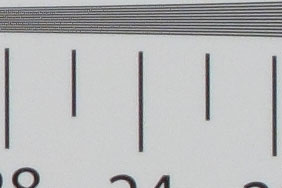 | |
2450 lpph, 6.1-30.5mm at 15mm, f3.5, 80 ISO |
2600 lpph, 6.1-30.5mm at 15mm, f3.5, 80 ISO |




